Mint Condition
The ads sell dreams, ephemeral snacks of nostalgia enshrined in hand-painted porcelain, yours for only three easy payments of $29.95--and, all over the world, collectors are happy to shell out $800 million a year, making the Franklin Mint not just a mega-producer of glossy bric-a-brac, but a wildly successful player in the corporate arena
By Christina Waters
EVERY SUNDAY THEY APPEAR, those full-page, color ads for Victorian dolls, Santa figurines, plates commemorating something Babe Ruth did decades ago, Fabergé music boxes my grandmother would have killed for. All from the Franklin Mint. Betty Boop, pouting saucily in cast resin--"inspired by an authentic animation cel"--is mine for only $37.50.
Another ad offers "the first-ever shamrock-shaped heirloom collector plate" depicting a cozy thatched cottage embellished by the tired Irish toast, "May the road rise to meet you--may the wind be at your back" in emerald-green lettering. The ad proudly italicizes the fact that the shamrock-shaped plate is "bordered in 24 karat gold," offered in a limited edition that "will be closed forever after 45 firing days." Which means that only 5,000 to 10,000 or so of these will be made. In a heady gush of exclusivity, the ad teases "Limit: one plate per collector."
Simultaneously fascinated and repelled, I found myself turning to the magazine newspaper inserts each Sunday to find out what new collectible version of the Hallmark moment would be pitched. There, in porcelain, was Marilyn Monroe, dressed in her pink Lorelei Lee outfit from Gentlemen Prefer Blondes and the crew of Star Trek ready to mount a Level Three diagnostic. My clipping file soon grew to include ads from Franklin Mint competitors, kitsch houses like Ashton-Drake Galleries, Christian Fantasy Collectibles, the Hamilton Collection, Danbury Mint, Bradford Exchange, the Georgetown Collection--groups whose bad taste rose like clouds of cheap perfume from the newsprint pages.
Forced to consider that my fellow Americans were coughing up hard-earned money on figurines of little boys urinating, plates covered with fat angels and bad poetry, the die-cast replica cars and American eagle bone china by the Franklin Mint began to look downright tasteful. And to see if there really was no accounting for taste, I needed to go to the source.
The Pearls
'TRY THEM ON," urges Franklin Mint Vice President Jack Wilkie in the buttery tones of a man who has never heard the word "no." As the silver clasp is snapped into place, I feel the pleasurable weight of the three strands of pearls--just like the fake ones Jackie Kennedy Onassis really owned and really wore when she was married to the golden-haired god, Jack Kennedy. Not the least bit tacky, they look terrific. I find myself mentally making a purchase.
The Resnicks, Stewart and Lynda--the dynamic duo who own, operate and oversee every inch of the Mint's busy empire--went to the trouble of forking over $211,500 at the hugely hyped Sotheby's auction for the original faux pearls owned by Mrs. Onassis and worn by her in several famously unforgettable photographs. Those photographs and their residual romance grace the Mint Museum's newest display. In one, Jackie lounges in the sun, her ripe, lovely face forever young and framed by Those Pearls. In another photo, young John-John tugs playfully at the pearls, inducing a head-thrown-back laugh from the bewitching First Lady. Bittersweet those images, gone those moments.
But why mourn for Camelot, when you can wear it? Own some of that collective unconscious, for only "5 equal monthly installments of $39 each." Never mind that what you actually have are glass and powdered seashells, hand-knotted, of course, and clasped with genuine silver, cast from the original, which itself was a 1950s reproduction of a 1930s jewelry finding.
"People want to be close to Jackie," smiles Jack Wilkie.
Others maintain a less warm-and-fuzzy perspective. "They're selling a fake," contends Bill Miller, owner of Odyssey Group, a Southern California dealership in autographs and celebrity memorabilia, which publishes Collecting magazine. "There's as much mystique in those pearls as there would be in taking a photograph of a Van Gogh. The original fake pearls sold for big bucks, "because she actually owned them--she wore them," he scoffs.
"Hers were a one-of-a-kind original," says skeptic Miller. "Theirs is a mass-produced facsimile."
Let's review briefly. There's real hands-on proximity, and then there's illusory proximity by type--a connection implied and massaged by mimicry. I can hear the ghost of P.T. Barnum now, cackling over these market-driven associations, reminding us of all those suckers born every minute. These pearls look like hers, so they must have the same magic as hers. If I wear them, I can feel like Jackie.
A company man right down to his socks, Jack Wilkie doesn't claim that the $195 pearls are Jackie's, or even that they are genuine pearls. But they are a real reproduction of a real reproduction owned by the Franklin Mint. "Jackie made rhinestones look like diamonds," Wilkie contends, defending the troublesome fakeness of the necklace. "And they cost $275 in the '50s--that was a lot of money in the '50s. We went to some trouble to recreate it," he insists. "It's an absolute duplicate."
Multiplication Fables
ART FOR THE MASSES--"junk," "art," "trash" and "high-end trinkets"--every aesthetic epithet and expletive has been thrown at the Franklin Mint and its spawn. "The Mint has gotten a bad reputation for co-opting art," complains Jan Galperin, a former freelance giftware designer who recently joined the Mint's full-time staff. "They provide a bit of beauty that people can afford to own," she insists, appealing to my sense of democracy.
"I hate snobs who put down mass production," Galperin adds. "After all, every single item in your kitchen was designed by a real person." Galperin also admitted that she could no longer be an objective informant now that she had scored a full-time job with the Mint. "I'm going to be pro-Mint, absolutely," she acknowledges. "But I would have been even before I got this job."
Art for the masses. The targeted fantasies are radiantly clear--nostalgia for the past, Hollywood icons, sports stars, holiday symbols, wild animals and native Americana. The Mint flatters our favorite versions of our collective self/myth--strong, untamed, heroic, spiritual and, ideally, rich as hell. The Jackie pearls--"available exclusively from The Franklin Mint," the words jump off the page.
"Before the invention of the printing press," Philadelphia art dealer Charles More reminds me, "few people could actually view original artwork. But once reproducible images were possible, an artist's work could enjoy a wider audience." More, who dismisses the Mint's ad campaigns as "fish wrap," says, "There's a whole tradition of exhibiting an original artwork, and then selling reproductions of it as an inexpensive lithograph or engraving. Winslow Homer did it, Currier & Ives did it. Even Dürer would take his prints to country fairs and sell them."
But it's not simply visual reproduction that's being sold. "You're closer to Jackie with these pearls--that's what they want you to believe. It's about the name, the image, the saint's relics," More explains. "That's the heart of the business, after all. Nostalgia. Maybe in 50 years, they'll be selling faux pieces of the Berlin Wall."
Jackie Davis, a Mint freelance sculptor for the past 17 years, agrees. " 'Art by committee, art for the masses,' that's what the Resnicks say. The Romans cranked out multiple copies of coins and busts of their leaders. It extended the empire and let people know who was important--it was a way of spreading popular culture," Davis says.
Davis defends Mint output as being of excellent quality, especially since the Resnicks took over in 1985, purchasing the company from Warner Communications for $167.5 million. "For a while there, during the recession in the '80s, they made smaller, cheaper stuff, some of which was kind of awful," says Davis--who admits that she knows people who are crazy about the Mint's Three Stooges plate. She thinks the collecting of miniature heroes and romantic tableaux is "a way of having a beautiful castle, or home that you can't actually own. I think the world of doll collecting may be something like that too, about the miniature, the manageable. It's universal. It's not something the Franklin Mint invented. "But grown-up women who collect dolls," she laughs. "What's that all about?"
Joe Castro, whose San Jose shop Time Tunnel specializes in popular culture memorabilia, dislikes the Mint's strategy of creating "instant collectibles." Castro likens it to the phenomenon of collecting baseball cards. "It's like a lottery for children," he fumes. "These companies get the kids hooked on buying these cards by packing one rare one, that's actually valuable, into every 500 cases or so. And the kids have to keep on buying in hopes of getting a treasure. I find it disturbing that they create this need." And he likens it to the need felt by Mint collectors. Castro notes that when the Mint specialized in commemorative plates, consumers thought they'd be valuable. "Well, the very first ones made probably were valuable, when the editions were small. But when the market gets flooded with a 'limited edition' of 100,000," he laughs, "it just becomes a marketing thing, like the pyramid scheme." Like most professionals in the antiques and collectibles businesses, Castro has little respect for the Mint's "heirloom" label. "They can't be heirlooms. They have no history." Patiently, Castro explains, "The collectibles thing began when people started having an appreciation for a certain item or theme. They'd research it and go and start looking for those items. There was nothing instant about it. Now," he notes with exasperation, "everyone's a collector. It's like a hobby." Castro believes that "some of the stuff the Franklin Mint makes is fine. But a collectible should be hard to find--not something you can just call up and order from a catalog." Offering his candid assessment, Castro adds, "No one that comes into my store would mention the Franklin Mint--it's something that people laugh at."
"What the Mint manages to do," says Frank Galuszka, a longtime Philadelphia artist and former City Arts Commissioner, "is to take an artistic source and surgically remove the meaning so that only the ornament remains. They've leveled out all the ambiguity that goes with great art."
Galuszka, who taught for 20 years at Philly's University of the Arts before he joined UCSanta Cruz's Art Board, believes that collecting the Mint's "high-class tshatshkes" is a way of belonging to an insider group. "They've created an ideal world--a catalog-order sense of community." He also finds the Mint guilty of paternalism and deceit. "The Mint keeps stressing quality--but it's all such derivative kitsch," Galuszka contends, adding that by pre-packaging nostalgia, "the Mint has engineered my response."
Neutered, the Mint decorative objet d'art calls forth only a safe, sanitized range of emotions.
Jackie Davis calls it "democratization of culture."
Galuszka's call is more direct. "It's spayed art," he says.
The Disneyfication Of Everyday Life
THE FRANKLIN MINT headquarters sprawl confidently atop a grassy knoll overlooking the Wawa Dairy Farm, 25 miles from downtown Philadelphia. I will need an electronic pass to get through the corporate front door, but across the driveway, the coin-shaped museum is free and open to all.
"It is only through art that we can realize perfection," intones the placard leading to a display of the company's greatest collectible hits, encased in thick glass and mounted on black velvet. Designed to showcase the major Mint themes, the curiously appealing little museum leads the viewer through a maze of niches containing state-of-the-art multimedia displays. Huge backlit photos of artists are intended to humanize the anonymous plethora of plates, music boxes and bell jars by the tens of thousands.
Surrounded by a diorama limbo of ruffled blue satin, a 3-foot-high mother in pink lace--showing telltale signs of machine stitching--holds an infant in white lace, their glass eyes forever fixed on some generic past. Beneath a procession of pewter cowboys, a display explains the time-consuming, labor-intensive process of lost-wax investment.
Much of the value of Mint products, I discover, is weighed in artisan hours, rather than artistic originality. Cases of magnificently wrought silver medallions commemorating this conquest and that anniversary keep uneasy company with saccharine ensembles of floral thimbles, spoons and boxes. There is a lot of preciousness here, some of it well-made, some of it verging on souvenir territory.
I enter a Star Trek module, where I'm bombarded by a multimedia electronic sound and light show. I push a button, and a Cardassian cruiser uncloaks against an inter-galactic sky. The hand-painted plates with adorable floral and holiday themes are around the next corner. But it's clear that this is no longer my grandmother's Mint.
One of the biggest spenders in the U.S. corporate community, with an annual advertising budget of well over $100 million, the Franklin Mint underwent its latest updating in 1994, when the Resnicks added retail outlets to the traditional catalog and direct-sales strategies. There are 60 such stores all over the country, ranging from modest mall outlets like the one I visited in Santa Rosa, to opulent shrines of consumerism housed on Rodeo Drive. And they're filled with the whole range of Mint products, from die-cast miniature autos to Elvis plates and Scarlett O'Hara dolls.
"We don't merely sell collectibles," Lynda Resnick tells us. "We're an entertainment company. We take people to another time, another place, and our retail environment offers a multitude of such destinations." Many of those destinations have designer addresses, like the Vatican Museum, which has replaced the Louvre as the latest in a long line of art world licensees happy to join forces with the Mint's artistic gene pool and massive advertising budget.
Miniature Cadillac El Dorados are displayed along with a solemn vow that "Franklin Mint Precision models will continue to maintain its leadership role in keeping automotive history alive." The empire takes itself very seriously.
The Collection Agency
JACK WILKIE'S OFFICE is the perfect postmodern metaphor. Hillary Clinton's profile adorns a weighty silver medallion, minted as a philanthropic award, and sits in a cabinet right next to a leather-bound first edition of Martin Cruz Smith's Rose, a few tiny Harley choppers detailed right down to their leather fringed seats, a Gothic clock, an utterly unlifelike 2 1/2-foot porcelain tiger and an autographed photo of the crew of the Starship Enterprise, vintage James T. Kirk. There is not an artist's signature anywhere among these anonymous icons of pop culture.
Wilkie is very high on the new movement of the Mint toward higher-quality and corporate alliances. "Coins are only 1 percent of what we do these days," he says as I run to follow his pace through the bowels of the headquarters' energetic mix of factory/art studio/marketing thinktank. Glossy posters of Shakira Caine, Yvette Mimieux, Gloria Vanderbilt and Sophia Loren line the office suites, all throbbing with fiscal energy. "They," Wilkie points to the celebrity images, "pay for exposure, and we give them maximum exposure.
"The first floor is pretty much all marketing," Wilkie explains as we check in with a real live artist at her drawing board, revising a carousel motif for its future destination on a cookie jar.
"They wanted a few changes, so I enlarged this, tweaked that," she explains, holding up an elaborate pencil sketch.
"Carousels are a huge collector theme," Wilkie nods vigorously. "Home values are big now. Hey, let's put Scarlett and Rhett on the carousel," he jokes. They both laugh.
"We've got 8, 10 million people who are Franklin Mint collectors," Wilkie reveals proudly. "Integrity and quality, that's what it's about. We take the intangible and manifest it. Like with Coca-Cola. People associate certain good times, good memories with a Coke. So we turn it into a kid. And we get Danny," he beams.
Danny, with porcelain face, hands and feet, is clothed in the kinder, gentler garb of the turn of the century. And he's got a whole spin-off family of relatives, toys and accessories.
Patrick Stewart waits patiently on the next drawing board, soon to be turned into a doll as part of the Star Trek spin-off empire that's doing very nicely for FM. A Laurel Burch cat plate is being photoshopped on a bank of Macs into a future three-dimensional vase. Mesmerized, I peek into the private workshop of Ralph Bienart, a senior staff sculptor who's painstakingly applying and then carving bands of malleable "sculpy" to a mold of one of those egg-shaped shadowboxes Mint collectors adore.
This man, who seems to wince when introduced--or maybe that was an attempt at a smile--has great skill and talent. Why is he sculpting an egg for someone's china cabinet?
"I started at the Mint after art school because it was local and easy--they always hired lots of freelancers, which meant I could work at home," recalls freelance sculptor Jackie Davis, one of the few Mint workers who would talk with us, either on or off the record. "There are many fewer staff artists than there used to be; many were laid off but were re-hired as freelancers."
Davis insists that she finds ways to make her Mint assignments interesting, "even though I wouldn't have chosen to do them for myself." In an era of arts organization downsizing, Davis, like Galperin, considers herself very lucky to have work in her chosen field. "It's a business, like everything else in the capitalist economy," notes Davis. "If people buy this stuff for investment--whether it's art, jewelry, antiques--they have to realize that the dealers and agents have to make money. Caveat emptor applies--like in everything."
Lynda Resnick describes the themes that link all Franklin Mint products as "fine artistry, exceptional quality, prestige and value." Those terms could certainly be applied to the Franklin Mint Rotunda, a gallery in the Philadelphia Museum of Art, housing a bevy of Renoirs and Cezannes and named thanks to a generous $1 million gift from Lynda (who serves on the museum's board) and Stewart Resnick. The Los Angelesbased Resnicks between them sit on boards of the L.A. County Museum of Art, New York's Metropolitan Museum of Art and the National Gallery of Art, continuing a long, time-honored tradition of nouveau riche art patrons paying the appropriate dues for entrée into polite society.
The Dealer
A BEWILDERING bonanza of thousands upon thousands of porcelain objects bombards the eye at Rystad's Limited Editions in Willow Glen. Disney characters and Oz statuettes line up right behind a wall of colorful plates commemorating the life of Elvis in all his full--and full-blown--glory. Marilyn Monroe pouts on at least two dozen different dinner-sized plates, and an entire wall is devoted to blue and white Danish Christmas souvenirs from the past 90 years. American Indians, Victorian children, adorable puppies, plates of Jesus, plates of Pocahontas, plates of wolves and umpteen John Wayne collectibles perch precariously on every available surface.
Dean Rystad, who has been a professional dealer of limited edition plates and figurines since 1967, is down on his knees looking over a stash of heirlooms brought to him for both appraisal and sale. His expert eye takes but a minute or two and then he makes an offer. Immediately accepted, this transaction produces smiles all around. An acknowledged expert in his field, the cherub-faced Rystad is in the business of making people happy. And nothing pleases him more than doing just that.
It all started with that first blue and white Bing & Grøndahl Christmas plate he saw one summer as a student at the University of Oslo. "I got intrigued by the idea that only a certain amount of them were made, and then the mold was destroyed," Rystad recalls. "So I bought a couple of them, including one for my father's birth year, 1905. And pretty soon I started collecting." One thing led to another, including a business, which grew so successfully that Rystad was able to give up his "day job" as a high school teacher and devote himself entirely to his collecting passion.
"I moved to my current location the end of 1980," he guesses. "Being an authorized dealer of a certain line, like Bradford Exchange, means that we can obtain the entire line for our customers." Today Rystad's expertise attracts collectors from all over Central California and, thanks to the Internet, he now gets special requests from as far away as New Zealand.
What's the advantage to using Rystad's services, when collectors can simply order direct using the forms provided in ads? "We don't charge shipping and handling, unlike the mail orders. And that's attractive to people. Also, when they come to us, they get to see the actual plate or figurine first. And sometimes the looks of the ad can be misleading."
Back in the '70s, Rystad was a Franklin Mint dealer. "In those days they were doing everything in silver--Christmas plates in sterling silver by Norman Rockwell, silver ingots and silver Christmas ornaments," he says. "Then they decided to go direct mail and not use dealers anymore." Rystad actually had two Franklin Mint plates--white embossed Christmas commemoratives--in his shop last month. "About the only time I ever obtain an FM product is if it's part of a collection that I buy. But there's really not enough of any one item made to be interesting, and there's very little call for FM products after they've been issued." Part of this is that Franklin Mint never keeps supplies of previous issues--when they're gone, they're gone.
"The main contention I have with them is that their ads and letter to customers often show prices of certain items increasing in value," he says, recalling an $8.95 Mother's Day plate shown to have appreciated to $300. "Well, it did increase in value--but it wasn't their product. It was a Bing & Grøndahl product--but they never said that in the ad," he huffs.
"I think people love to collect because they enjoy searching for pieces--it gives them a mission. Psychologists say that collecting is great for mental health because it keeps people occupied--it gets their minds off boring jobs," he laughs.
Yes, there is a lot of tacky stuff being made, Rystad agrees. "I see products at the trade shows I go to that I wouldn't bring into the store--it's what I call 'junk.' I have to do an awful lot of screening in this business. Every day we get all kinds of catalogs and, frankly, I wonder why most of it was made."
The Collective Metaphor
'IT'S AN ORIGINAL in the sense that you can't get it anywhere else in the world," insists Jack Wilkie, enthusiastically hefting the plaster model of a carved eagle in one hand while pointing out the 18-piece polyurethane mold from which its multiple copies will be produced. "We really expose art to the broadest segment of the population," he says, as I inhale the aromatic paint thinner perfume of the handpaint room, where hundreds of tiny jars of enamel paints surround several artists.
One worker is painting dozens of roses the size of a baby's thumbnail. It's soothing just watching her going over and over the curves with hues of pink and scarlet. "If something works for us," Wilkie reveals, "we keep doing it and doing it."
Passing a design team in the hallway, we pause for Wilkie to admire a new porcelain ornament authorized by the Vatican. "It's gorgeous, it's gorgeous," Wilkie says. I swear one of the designers winks at me.
"There's McDonald's, and then there's the original--in between there's us," Wilkie smiles triumphantly and pulls the handle on an anatomically correct Caesar's palace slot machine. "Like the Monopoly game. People loved it. It was huge. So we made a Monopoly table. And then a clock, then we did jewelry."
We pass a security command center with 30 video monitors, and Wilkie points out the video-conferencing room that links designers and marketers all over the world.
What about the plates?
"Oh sure," he says, "we'll always keep doing the plates. The porcelain shells are made in Japan, the color decals [the design-bearing lithographs that will be fused under heat with the plate shell] are made in Paris, and they're fired somewhere else.
"We don't track the secondary market," claims Wilkie, though he does mention that a Mint bowl with an Andrew Wyeth design has ballooned in value to around $7,500. "We try to make an heirloom; the value is really intangible." Wilkie insists that his company isn't about limited editions. "Our mission isn't to limit. Of course, on some pieces, we have limited them because we have an audience that wants that--that wants exclusivity. Some plates have only certain numbers of firing days," he pauses. "It does give some urgency to the purchase."
True Believers
ON THE INTERNET'S rec.collecting newsgroup, you can find opinions trashing Mint consumers as "suckers" or defending specific products as "absolutely magnificent." Mickey Kaz, an admitted Mintoholic, notes that "almost anything they make, they sell. They make such a splash with all the advertising that one cannot help but be intrigued enough to buy."
Ah, those easy installments. Betty Parker of Lanett, Ala., wrote to tell me that she'd bought a collection of Western sheriff's badges from the Franklin Mint for her husband's 50th birthday. "My husband likes old Western movies, John Wayne etc. I came across this little collection of ads. I thought they were kind of neat. I was looking for something special to give him for his birthday. I think the FM collection is very attractive and makes a very good display as well as a conversation piece."
From the Philippines, Alan L. Mescallado poured forth his story of collecting books from the Franklin Library of classics. "When an ad in an American magazine introduced me to their Signed First Editions Club, I wanted so much to get the books under that program, but I didn't earn enough. When my pay increased enough to allow certain liberties, I quit the old book program and subscribed to the Club." Still hooked, Mescallado is waiting for his immigration visa, "so my wife and I can start a better life. Also, access to the Mint is an advantage. I love their Monopoly, Chinese Checker, Fabergé chess, Star Trek 3-D Chess and Fabergé domino sets. I hope I'll be fortunate enough to own most, if not all."
THE MINT offers instant collections, instant insider status. Not so much the stuff that dreams are made of as the delivery of the dream itself, Mint collectibles may be best explained by one of those irrepressible French philosophers who probe the human psyche with such obsessive accuracy.
Jean Baudrillard equates the collectible with a beloved object, calling collecting an infantile and rudimentary attempt to control our world--an effort that begins at puberty, submerges and then re-emerges during mid-life crises. In The Culture of Collecting, he suggests that the mid-life phenomenon amounts to a stage of anal regression.
"Men in their 40s seem most prone to the passion," he explains. "The activity of collecting may be seen as a powerful mechanism of compensation during critical phases in a person's sexual development." Like an immobile pet, the collection offers itself to its owner. "I am able to gaze on it without its gazing at me." I am the master, it is my subject. "This is why one invests in objects all that one finds impossible to invest in human relationships."
Collections are perfect worlds into which we can escape. They calm us, they feed and reflect our neuroses. Basking in our collections, we can time-travel, schmooze with celebrities, re-live our childhoods, dwell in Camelot and never die.
The Franklin Mint--packaging our collective fantasies--gives us exactly what we want--or at least, what we deserve.
[ Metro | Metroactive Central | Archives ]
This page was designed and created by the Boulevards team.
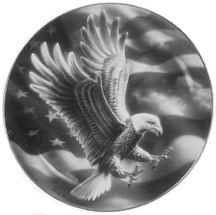
Plate Techtonics: The Franklin Mint pumps out a steady stream of plateware that strives to capture America's most magical, unlived moments. 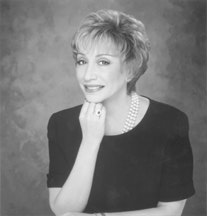
Embrace Your Inner Jackie: Franklin Mint Vice Chair Lynda Resnick wears the real thing--Jackie O's faux pearls-- now available in mint reproduction at a price Camelot fantasizers can afford.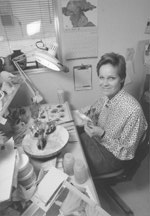
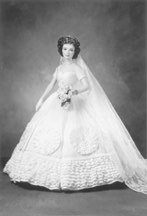
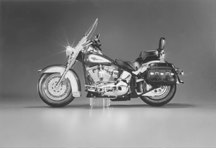
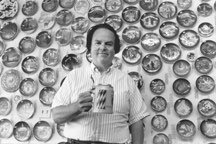
Limited Addition: Willow Glen collector Dean Rystad says some collector plates have appreciated in value slightly, but nothing like the Franklin Mint's hype.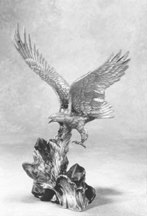
Big Bird: The Mint's bald eagle sculpture, by Ronald Van Ruyckevelt, has been presented to such leading patriots as Ronald Reagan and Bill Clinton.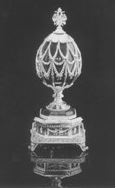
From the September 26-October 2, 1996 issue of Metro
Copyright © 1996 Metro Publishing, Inc.
![[Metroactive News&Issues]](/gifs/news.gif)